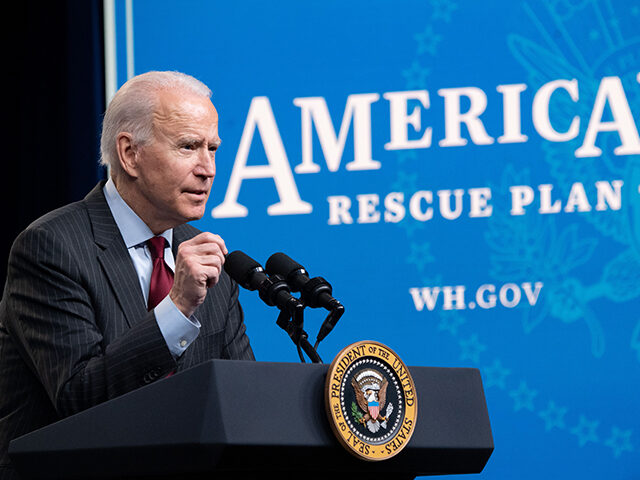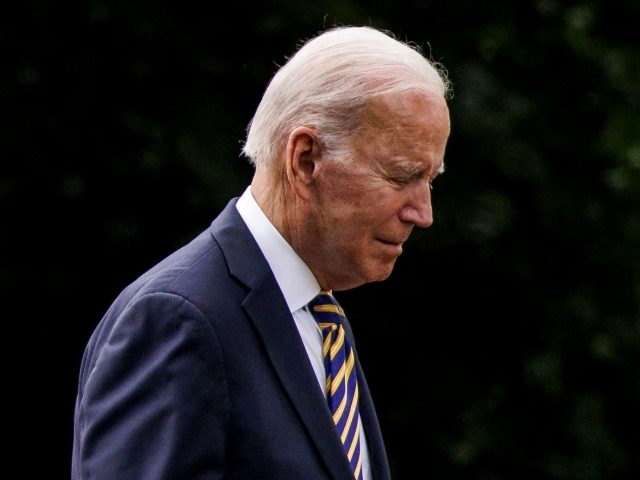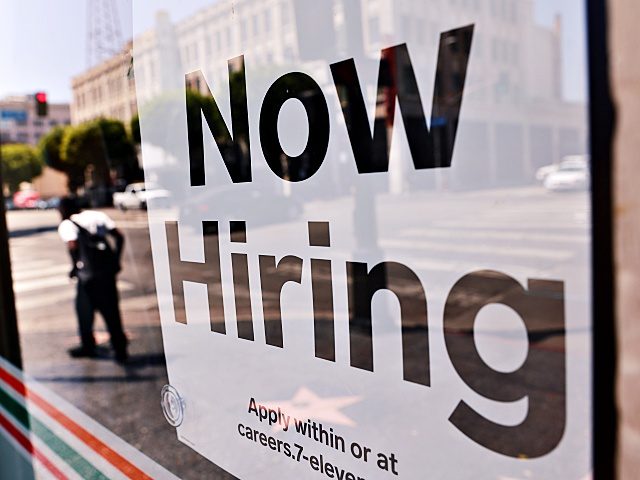With Biden in office, America’s southern border has vanished entirely.
https://mexicanoccupation.blogspot.com/2022/06/is-joe-bidens-open-borders-destroying.html
Breitbart Business Digest: How Biden’s ‘Rescue Plan’ Wrecked the Economy

It’s now becoming much clearer just how unnecessary the Biden administration’s 2021 spending spree was and why it sparked the worst inflation in decades.
The government on Thursday released its revised estimates for economic growth in 2020 and 2021. The new figures show the economy contracted by less than previously thought when the pandemic first struck and recovered more quickly than earlier estimates indicated.
The August estimates for Gross Domestic Product in the last year of the Trump administration, when the pandemic descended upon the country, showed output falling by 3.4 percent. The revised estimate says the decline was just 2.8 percent. Consumer spending was significantly higher in 2020 than was believed. The latest figures show it declined by three percent instead of the earlier estimate of 3.8 percent.
This highlights the inaccuracy of the accusations that Trump’s alleged “mishandling” of the pandemic had “bungled” the economy, a key part of Joe Biden’s campaign pitch. In the second quarter of 2020, when much of the economy was subject to severe lockdown restrictions, the economy shrank at a seasonally adjusted annualized rate of 29.9 percent, the new stats show. The earlier report had it shrinking at a 31.2 percent rate. The following quarter the economy grew at a 35.3 percent rate, revised up from 33.8 percent. At the time, Biden’s campaign was saying that Trump’s effort to campaign on an improving economy was a “desperate scheme.” Now we know the economy was indeed improving.
The narrative that Trump had left the economy in shambles led directly into the disastrous American Rescue Plan, the $1.9 trillion spending spree enacted shortly after President Biden took office. It was because Biden and fellow Democrats had loudly insisted that the nation’s economic affairs had been “bungled” that they could now claim it needed to be rescued. Indeed, they had to pass a large stimulus act in order to create a plausible case that they were responsible for the recovery that was actually already underway.
The GDP estimates show that the economy grew at a 6.3 percent rate in the first quarter of 2021. The following quarter it grew at a 7.0 percent rate, up from the earlier estimate of 6.7 percent. Meanwhile, nondefense government spending soared at an annualized rate of 64.8 percent in the first quarter, up from the prior estimate of 40.8 percent. For the full year, nondefense spending was up 7.3 percent from the hugely elevated pandemic spending level of 2020, much higher than the earlier estimate of 2.8 percent.
Personal consumption expenditures ripped 8.1 percent higher in 2021, upwardly revised from the earlier estimate of 7.9 percent. Spending on durable goods jumped 18.5 percent on top of the ten percent rise in 2020. Those figures are revised up from 18.1 for 2021 and 7.7 percent for 2020. Services spending in 2020 dropped by 6.6 percent, the new figures show, rather than the 7.5 percent estimated earlier. The following year, it rose 6.3 percent, a half a percentage point above the earlier estimate.
In short, the massive and unnecessary fiscal expansion of Biden’s first year in office pumped up demand so much that it set the economy on track for the worst inflation in four decades.
Biden Fiddles While Inflation Blaze Burns On
And he lies about his record on inflation.

President Joe Biden is not only in a state of denial about the surge of inflation that his reckless spending has let loose. He continues to lie to the American people.
For example, most recently on September 26th, President Biden claimed that the price of a gallon of gas had decreased “below three bucks” in “some few states.” That’s a lie.
As reported by ABC News, “according to AAA gas price averages by state, no state in the U.S. has an average gas price below $3.00 as of Sept 27.”
On September 26th, the same day that President Biden also falsely claimed that the price of gasoline was “in the low threes in most places,” AAA reported that “the national average pump price hit $3.72.”
During President Biden’s “60 Minutes” interview on September 18th, the president tried to play down the inflation problem. “Inflation rate month to month was just– just an inch, hardly at all,” he said. “We’re in a position where, for the last several months, it hasn’t spiked. It has just barely– it’s been basically even.” This distortion of the real toll that Americans are experiencing from the highest inflation rate in the United States in the last forty years is of little comfort to the millions of people coping with skyrocketing prices for necessities such as food and shelter.
In true Marie Antoinette “Let them eat cake” fashion, the Biden White House threw an Inflation Reduction Act party on the same day, September 13th, that the latest Consumer Price Index (CPI) numbers showed that inflation is not going anywhere anytime soon. James Taylor entertained the White House guests with a rendition of his 1968 hit “Fire and Rain” as the stock market indexes were plummeting. The Dow Jones Industrial Average fell nearly 1,300 points in response to the dismal inflation news. The stock market is still going down as recession looms on top of inflation.
The latest year over year CPI increase from August 2021 to August 2022 was 8.3 percent. The cost of food rose by 11.4 percent year over year, the largest 12-month increase since the period ending May 1979. Electricity prices rose by 15.8 percent while shelter prices rose by 6.2 percent year over year.
The American people are paying outrageously high prices for basic necessities like food, shelter, and gasoline but the Biden White House partied like it was 1999. Perhaps James Taylor should have sung Prince’s hit “1999,” the song from which the words “parties like it’s 1999” came from.
The White House displayed utter tone deafness in holding their celebration of the misnamed Inflation Reduction Act, which will do nothing to reduce inflation, on the same day that the latest CPI numbers were announced. President Biden’s remarks only added to the surreal atmosphere.
“This is the extraordinary story being written today in America by this administration,” the president told his enthusiastic audience. It sure is an “extraordinary story” that has been written by the Biden administration since it took office – an extraordinary story of failure.
An extraordinary story of inflation that has surged to historic levels since President Biden took office.
An extraordinary story of more than two million illegal immigrants crossing Biden’s open border in this past fiscal year alone, who are straining public resources after being released to go wherever they want in the country.
An extraordinary story of rising crime in the streets not seen since the 1970’s.
An extraordinary story of a chaotic withdrawal from Afghanistan, which left 13 American service members dead, American civilians and Afghan allies left behind, and the abandonment of billions of dollars of sophisticated military equipment.
But President Biden was just getting started with his message of self-congratulation. “This is what it looks like when the American government works for the people,” he said.
Just imagine how the American people would be faring if the president and his tax-and-spend fellow Democrats had not worked so hard to pass their fiscally irresponsible legislation. We might have had an inflation rate closer to the 2 percent level that prevailed during the days of the Trump administration when the American people could better afford groceries, gas for their cars, and housing.
President Biden claimed that the Inflation Reduction Act “helped reduce inflation at the kitchen table.” Really? Where are the provisions in this legislation that will help reduce the cost of foods at the kitchen table like meats, poultry, fish, and eggs, which rose in price by 10.6 percent from August 2021 to August 2022? How about the price of cereals and bakery products, which rose by 16.4 percent during the same period, or the price of fruits and vegetables, which rose by 16.2 percent?
The answer is that the highly touted Inflation Reduction Act does absolutely nothing to help reduce the pain of these rising food prices for the American people. The same is true for the price of shelter, which rose 6.2 percent from August 2021 to August 2022, unless you want to live in a federally subsidized electric vehicle or perhaps inside a wind turbine.
When White House Press Secretary Karine Jean-Pierre was asked what the Inflation Reduction Act would do to reduce inflation in the short term, she fumbled for an answer. “So I — I — when you look at the lowering costs, in particular, for Americans,” she said, “I think that’s important when you think about how inflation has — has increased cost for American — Americans,” before citing some small potential savings in Obamacare premiums.
Claiming that the Inflation Reduction Act will reduce the deficit, President Biden said, “I don’t want to hear it anymore about “big spendin’ Democrats.” We spend but we pay.”
Yes, Mr. President, you are paying. You are paying off college student loans with taxpayer money and with no plan on how to offset the enormous cost.
During an address on September 23rd at a Democratic National Committee event, President Biden said that because of the reduction in the deficit that he claimed credit for, “we can afford to cancel $10,000 in student debt and $20,000 if you’re on a Pell Grant for tens of millions of Americans making under $125,000.” That is another one of the president’s whoppers. We cannot afford this reckless program at all.
The non-partisan Congressional Budget Office (CBO) issued a letter on September 26th stating that, after accounting for suspended loan payments, interest accrual, and involuntary collections from September 2022 to December 2022, “CBO estimates that the cost of student loans will increase by about an additional $400 billion in present value as a result of the action canceling up to $10,000 of debt issued on or before June 30, 2022, for borrowers with income below specified limits and an additional $10,000 for such borrowers who also received at least one Pell grant.” The CBO added that the net effect will be to “increase the amounts that the federal government borrows over time.”
The University of Pennsylvania’s Penn Wharton Budget Model had estimated a higher cost incurred for the debt cancellation portion of President Biden’s plan alone than the CBO estimated – as much as $519 billion over 10 years. If all elements of President Biden’s student loan relief plan are taken into account, the cost estimate would be significantly higher.
This college student loan giveaway is yet another example of reckless spending by the Biden administration, with the backing of tax-and-spend congressional Democrats, which is adding fuel to the inflation fire. President Biden wants the American people to believe him that inflation is under control rather than believe what they are experiencing every day in their own lives as they try to make ends meet. His smoke and mirrors won’t work.
Reader Interactions
Biden’s Mass Refugee Invasion is ‘Uncapped’

After Biden massively increased the number of ‘refugees’ entering America, the administration is pretending that it has some sort of caps in place.
It doesn’t.
Refugees advocates have been pushing the Biden administration to do more to restore the U.S. Refugee Admissions Program. The more than four-decade-old program suffered deep cuts under the Trump administration, which slashed admissions to a record low of 15,000.
After taking office, Biden quadrupled the number of refugee admissions permitted for the remaining months of the 2021 budget year. He then set the target at 125,000 for the 2022 budget year, which ends Sept. 30. But so far fewer than 20,000 refugees have been admitted.
That number excludes the roughly 180,000 Ukrainians and Afghans who came to the United States via a legal process called humanitarian parole that got them into the country more quickly than the traditional refugee program but only allows for stays of up to two years.
When you’ve got 180,000 “refugees” pouring into the country in a number far larger than the 125,000 cap, that means there’s actually no caps.
And “humanitarian parole” is much bigger than that. The only rule is that there are no rules. Formal caps are routinely bypassed and sidelined. Migrants are able to cross the border and apply for asylum. Mobs pour in demanding their piece of a shrinking pie. Everyone is now a refugee and the claims of refugee status are numberless.
Reader Interactions
Surprise! The Economy Is Even Worse Than You Thought

The U.S. economy was even weaker in the first half of the year than previously thought, data from the Commerce Department indicated on Thursday.
Gross Domestic Product contracted by 1.6 percent in the first three months of 2022 and by 0.6 percent in the April through June quarter, meaning the economy shrank for two consecutive quarters.
Those who argued that the economy was not actually in a recession could point to the low unemployment rate and a measure of the economy known as Gross Domestic Income, which had been reported as growing 1.8 percent in the first quarter and 1.4 percent in the second quarter.
On Thursday, the Commerce Department released revisions to its estimates of GDP and GDI. The GDP estimates were unchanged but the GDI estimates for the first half of this year were marked down sharply. First quarter GDI grew at a 0.8 percent annual rate and second quarter GDI growth was a mere 0.1 percent.
Many economists look to the average of GDI and GDP as a signal for the health of the economy. Prior to the revisions, that average appeared to imply that the U.S. economy was growing in the first half of the year, supporting the claim that the U.S. economy was not in a recession. After the revisions, the average of GDI indicates the economy shrank 0.3 percent in the second quarter and 0.4 percent in the first.
The National Bureau of Economic Research’s Business Cycle Dating Committee, the official arbiters of when recessions begin and end, will use the average alongside other economic indicators in its determination. The revisions make it more likely that the committee will decide that the U.S. economy entered a recession in 2022.
The estimates of both GDI and GDP are produced by the Bureau of Economic Statistics, a unit of the Commerce Department. GDP is defined as the value of final goods and services and is measured on the production side. GDI is measured by adding up wages, profits, interest payments, and investments. In theory, both should be the same since both a measuring the growth or contraction of economic activity.
In practice, however, GDP and GDI often fail to perfectly align, particularly in the early estimates. In the wake of the pandemic, the divergences became particularly sharp, suggesting errors in one or both measurements. Economists suspect that the sudden stops and starts to the economy and the huge amounts of government inject stimulus have made economic activity more difficult to measure. Prior to Thursday’s revisions, GDI was reported as being $773 billion higher than GDP. After the revisions, the gap narrowed to 1.3 percent.
The government also revised GDP upward for 2020 and 2021, primarily because consumer spending and exports were higher than previously thought. This means the economic weakness brought on by the pandemic was not as bad as originally estimated and the recovery begun under President Donald Trump was stronger. it also helps explain why the Biden administration’s aid packages helped spark the highest inflation in decades. The economy—especially consumer spending—was already well on the way to a full recovery and the additional stimulus overheated demand.
Poll: Just 36% Approve of Joe Biden 41 Days out from Election

Just 36 percent of voters approved of President Joe Biden 41 days out from the midterm election, a Wednesday Grinnell College National Poll shows.
Biden’s approval rating is drastically fading, which indicates the Democrats could have huge losses come election day. Fifty-one percent disapprove of the president, a 15 point deficit.
A presidential approval rating is a key indicator of how the electorate will vote in the midterms. Polling shows the midterm election will likely be a referendum on Biden’s ineffective management of the nation.
Only 21 percent of Americans are satisfied with the direction of Biden’s America, a Gallup poll found Wednesday. Sixty-seven percent believe it is Biden’s fault the United States is on the wrong track. What is worse, just 35 percent of Democrats and Democrat-leaning independents favor Biden for the 2024 nomination.
Americans’ dissatisfaction with Biden and his management come while Biden’s sagging economy is the number one issue among voters. Only 35 percent do not believe Biden’s economy is in a recession. Of the 35 percent, 20 percent say the economy is souring. Fifteen percent say it is improving.
Overall, just 20 percent believe Biden’s economy is very good to fairly good, while 77 percent said it was very bad to fairly bad. Among independents, 51 percent say Biden’s economy is very bad, while two percent of independents said it is very good.
With the midterms six weeks away, Biden and the Democrats will have a tough time overcoming the negative data points. Republicans are expected to retake the House, but the Senate is a tossup. Yet even establishment Sen. Mitch McConnell (R-KY) has become more optimistic about the GOP’s chances of retaking the deliberative body with many conservative candidates.
Senate races in Pennsylvania, Arizona, Wisconsin, and Nevada have narrowed within the margin of error. In Ohio, Georgia, North Carolina, and Florida, Republican candidates still hold leads. New Hampshire appears to be the only swing state where Democrats have the largest advantage over Republicans.
The Grinnell College National Poll sampled voters from September 20-25. The margin of error was not provided.
Follow Wendell Husebø on Twitter @WendellHusebø. He is the author of Politics of Slave Morality.
Many Retailers Facing Collapse As Hard Times Are Coming
Survey: Nearly 7-in-10 Americans Searching for Extra Work Due to Surging Inflation

A majority of Americans say they are being forced to search for extra work as inflation increases the cost of living.
According to a recent survey by Bluecrew, a workforce service platform, 69 percent of Americans say they are actively looking for extra work hours, while 68 percent say they are reevaluating their current work situation.
Furthermore, 72 percent of Americans say inflation has impacted how they view their job, and 57 percent say they sought new or additional roles in the past year as the cost of living has ballooned since 2021 under the Biden administration.
Eighty-five percent of Americans said skyrocketing prices are affecting their spending and buying habits.
“Rapid inflation is forcing people to look at not only how they’re spending their money, but also how they’re earning their money,” Matt Laurinas, chief customer officer at Bluecrew, told CNBC.
During the pandemic, fewer individuals were seeking work, but high inflation is driving a rebound in the labor force participation rates, according to the Wall Street Journal.
While workers hope to take on extra work before the holiday shopping season, employers may not be as eager to hire due to recession fears and less consumer spending.
As CNBC reported, Walmart is planning on hiring 40,000 workers this holiday season, which is drastically down from the 150,000 retail workers and 20,000 supply chain workers that were hired the previous year.
That potentially puts the 58 percent of respondents who said they were interested in short-term work in a tight spot this holiday season. However, 65 percent did say they would consider opportunities that would go beyond the new year.
Even though a large number of those surveyed cited “work/life balance” (56 percent), “schedule/flexibility” (51 percent), and “prioritizing my mental health” (39 percent) as priorities when considering a job, most considered “wages/pay” (57 percent) as a priority for selecting a job.
The survey was conducted in September, asking more than 1,000 American workers from various backgrounds.
You can follow Ethan Letkeman on Twitter at @EthanLetkeman.
No comments:
Post a Comment